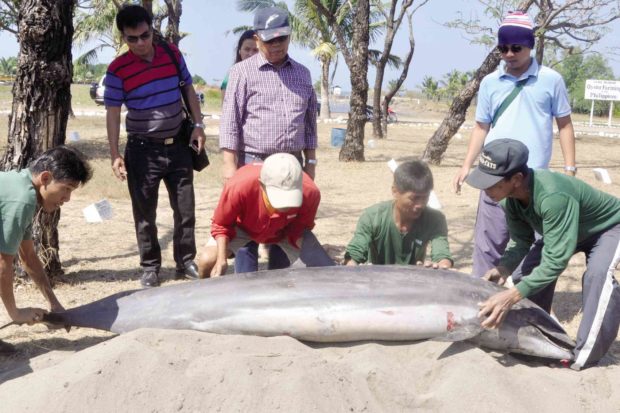‘Moby Dick’ started fish cemetery in Pangasinan

DOLPHIN BURIAL In this photo taken in 2015, workers of the Bureau of Fisheries and Aquatic Resources bury a dolphin at the agency’s fish cemetery in Dagupan City. —WILLIE LOMIBAO
DAGUPAN CITY — There are 39 reasons for marine lovers to visit the fish cemetery of the Bureau of Fisheries and Aquatic Resources (BFAR) research center at Barangay Binloc here.
These are the 39 sea creatures, which died from illnesses or human heartlessness, buried in what could be considered the ocean’s memorial park.
Each grave has a marker that reveals the dead animals’ tongue-twisting scientific names and the dates they were found and buried.
The grave marked “Moby Dick” stands out.
It is the very first sea animal that BFAR employees buried hastily but which they were unable to recognize.
“Moby Dick” is the 1851 novel about a white whale being hunted down by an obsessed ship captain, Ahab.
Expansion
The still unclassified whale, which weighed 1.2 tons, was brought to the facility after it was abandoned at a Malabon beach in 1999, said Westly Rosario, BFAR center chief.
From Moby Dick’s simple grave, the government center expanded and put up the 1,312-square-meter marine cemetery for large endangered species, which were collected by the BFAR or brought to the center by fishermen.
Through the years, 30 dolphins of different species, three whale sharks and five sea turtles were buried also at the cemetery.
The cemetery became an official government project in 2000 after six spinner dolphins (Stenella longirostris) were beached and killed by fishermen in Dagupan City.
Three dolphins were still alive when the BFAR responded to the stranding and were released back to sea.
In 2015, 10 beached dolphins died in different coastal towns facing the Lingayen Gulf.
Five Fraser’s dolphins (Lagenodelphis hosei) were stranded in January in Dagupan City and Lingayen town in Pangasinan province, and Aringay town in La Union province.
Dead dolphins
In May that same year, two dead Risso’s dolphins were surrendered by fishermen from Sual town and Dagupan.
Another Risso’s dolphin was brought to the center on Aug. 28, 2015, by Lingayen fishermen, while a spinner dolphin was found dead in San Fabian on the same day.
Hope was high that the Risso’s dolphin found still breathing on the Lingayen beach would survive. But it died on Sept. 1, 2015.
Respect
The other sea creatures buried at the cemetery were found in different coastal towns of Pangasinan and La Union from 1999 to 2018.
Each of these animals has a story to tell and visitors would learn about their fascinating tales when visiting the fish cemetery.
“The cemetery institutionalizes human respect for animals that contribute to the balance of aquatic environment but which are sometimes abused by humans,” Rosario said.